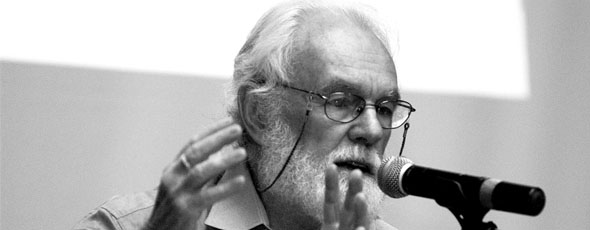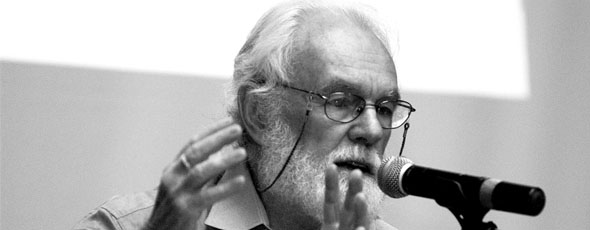The following is an interview published by the Occupied Times with Marxist geographer David Harvey.
Occupied Times: In 1968, Henri Lefebvre first introduced the concept of “the right to the city’’. He advocated the ‘rescue of man as the main protagonist of the city he has built…the meeting point for collective living.’ You have referred to this collective right – to remake ourselves and our cities – as ‘one of the most precious yet most neglected of our human rights.’ In what ways do you think we have neglected this human right in recent years?
David Harvey: If the question of what kind of city gets built depends critically on what kind of people we want to be, then the broad failure to openly discuss this relation means that we have abandoned the reshaping of people and their passions to the requirements of capital accumulation. It was, I think, very well understood by planners and policy makers that the suburbanisation of the United States after 1945 would not only help rescue the US from the prospect of a return to the depression conditions of the 1930s by way of a vast expansion of effective demand, but that it would also serve to create a social and political world devoid of revolutionary consciousness or anti-capitalist sentiment. Small wonder that the feminists of the 1960s saw the suburb as their enemy and that the suburban lifestyle became associated with a certain kind of political subjectivity that was class-prejudiced, exclusionary and racist in the extreme.
OT: London is praised as a multicultural city, and perhaps a significant component of the right to the city is the right to coexist. In re-imagining and remaking cities, how can we ensure that a city remade isn’t done so in a way that privileges or discriminates different interests or communities that exist in the city?
DH: There is nothing to ensure it other than social movements, active political engagements and the willingness to fight for one’s place. Conflict in and over the city is a healthy thing, not a pathology that state interventions must control and put down.
OT: We live in a digital age. In many cases, people develop more intimate relationships with people thousands of miles away than they do with their neighbours on the same street. If cities have tended, historically, to develop around shared physical space, how will communicative technologies that undermine the preeminence of physical/spatial communities, affect the future configuration of the city?
DH: The new technologies are a double-edge sword. On the one hand they can function as “weapons of mass distraction” and divert people to believing politics is possible solely in some virtual world. Or, they can be used to inspire and coordinate political action on the streets, in the neighbourhoods and throughout the city. There is no substitute for bodies on the street for political action as we have seen in Cairo, Istanbul, Athens, Sao Paulo, etc. Working together with active street politics, the new technologies can be a fabulous resource.
OT: Writing in ‘Whose Rebel City?’, Neil Grey suggests that in your most recent book, ‘Rebel Cities’, your analysis neglected the autonomous Marxist tradition first developed during in the urban struggles of 1960s and 1970s Italy – characterised by the ‘Take over the City’ slogan; feminist debates around social reproduction; the idea of ‘the social factory’ and so called ‘territorial community activism’ – instead focusing your theory on the absorption of capital and labour surpluses through urbanisation. How do you respond to this criticism? Do you agree that these political practices can serve as outlining models of how inhabitants might re-organise their cities?
DH: I find this criticism strange. To be sure chapter 2 is about the creation of urbanisation through processes of capital accumulation, but chapter 5 is devoted to class social movements in the cities. I could not cover all such movements of course and so there are many, such as those associated with the autonomista movement in Italy that are, I am sure, certainly worthy of inclusion. But I did look at the way the houses of the people earlier in the century in Italy complemented the factory council movements and of course took a lot of inspiration from the El Alto story as well as from the Paris Commune and other urban uprisings, while trying to theorise in what ways these could all be understood in the framework of class struggle. So, to say I was only concerned with the absorption of surplus capital is pretty weird and suggests Neil Grey either did not get to the end of the book or was dismissive of it because I did not deal with his particular favourite urban social movement.
I wish, by the way, I had cited Gramsci’s comment on the importance of supplementing the factory councils with ward committees: “The ward committee should also seek to incorporate delegates from other categories of workers living in the ward: waiters, cab drivers, tramway men, railwaymen, road sweepers, private employees, clerks and others. The ward committee should be an expression of the whole of the working class living in the ward, an expression that is legitimate and authoritative, that can enforce a spontaneously delegated discipline that is backed by powers and can order the immediate and complete cessation of all work in the ward.”
OT: On the heels of rapid urbanisation and an ever-inflating property bubble in China, you have spoken of a rising class struggle on the ground that people living in the West just don’t hear about. If we were to look more carefully at the situation in China, what could we learn?
DH: There is a lot more now coming out on China and an increasing recognition of the dangers of both urban asset bubbles of gargantuan proportions (particularly in housing) and a chronic problem of overproduction of urbanisation in response to the crash of export markets in 2008. There is now a lot of nervousness about urban overaccumulation. Theoretically, I understand what is happening but when it will come to a halt I cannot say. And we know there is a lot of urban and industrial unrest in China but it is very difficult to judge how much and of what significance.
OT: You place the concept you have termed ‘accumulation by dispossession’ at the heart of urbanisation under capitalism. Swathes of London are currently being transformed under the guise of ‘regeneration’, coupled with housing benefit cuts and the new so-called Bedroom Tax. One example of many, would be the hundreds of residents from the Heygate Estate in Elephant & Castle who have lost their homes so that property developers can replace social housing with ‘affordable’ properties. Grassroots campaigns have sprung up to resist these displacements, but they continually face policy and legal constraints. What are your thoughts on the importance and potential pitfalls of a unified movement across the city, or even wider?
DH: I think it vital to unify as far as possible struggles against dispossession across the whole city. But to do so requires an accurate picture of the forms of dispossession occurring and their roots. For example, there is at this time a need to put together a picture of the predatory practices of the property developers and their financial backers on a citywide basis, and initiate a collective citywide struggle to curb and control their practices. Recently, we have seen urban unrest in Brazil that is about transport costs but also against (and this is remarkable given we are talking about Brazil) the stadium-building for the World Cup and the displacement and waste of public resources that is involved, so citywide and cross-city struggles are not impossible. The danger, as always, is that the struggles may fade as people get tired of the fight. The only answer is to keep the struggles going and build organisations that have the capacity to do that (the MST in Brazil is a good example of this even though it is not a distinctively urban struggle).
OT: There is a distinct lack of commonly-owned space in London. Much of the city is privately owned and caters to the panopticon of surveillance, ‘do not trespass’ signage, and a dearth of public space free from market interference. Is it important to seek out and grow community spaces, to allow those resisting the depredations of capitalism to find the space not only to work, but to explore new avenues of creative interaction as well?
DH: The question of liberating spaces controlled by the state and turning them into a commons controlled by the people is, in my opinion, crucial. The rolling back of privatisation of public spaces is also vital and I would hope to see many more movements directed towards such ends.
OT: You have talked about the possibility of a “league of socialist cities” as a powerful way of changing the order of the world. Can you expand on what you mean, and how these could work?
DH: It is a bit of a far-out idea at first sight but there is a lot of benchmarking and best practice communication going on between cities and on some issues, like gun control in the USA, there are cooperative links between urban administrations that can have progressive results. I see no reason why such practices cannot build further into organised urban resistance to neoliberal practices. I think a coordinated response across urban administration in the UK to the so-called bedroom tax would be a possibility that would echo the way the struggle over the poll tax unfolded earlier. We have in fact done things of this sort but we don’t analyse them fully afterwards and appreciate their possibilities.
OT: Civil unrest is becoming a more recurrent feature of urban life in London, as it is for cities around the world, among them Athens, Madrid, Mexico City, Buenos Aires, Santiago, Bogotá, Rio de Janeiro and, most recently, Stockholm. Are riots (not just protests and organised social movements) now part of a toolkit to reclaim the right to the city? What can those here in the financial capital of the world learn from these struggles in other cities?
DH: Since inviting me to comment on these questions we have Istanbul. When you look at the global situation you sense there is a volcanic situation bubbling beneath the surface of society and you never know when and where it is going to explode next (who would have thought Istanbul, even though it was plain to me on my earlier visit there that there were a lot of discontents). I think we need to prepare ourselves for such eruptions and build as far as we can, infrastructures and organisational forms capable of supporting and developing them into sustainable movements.
OT: Whilst acknowledging the ingrained legitimisation of private property within the concept, what are your views on the efficacy of implementing a land value tax in the UK? Do you think it could achieve any of the equalising effects its proponents advocate?
DH: I think a land value tax could help but it does not, in the end, address the problem of the vast extractions of wealth by a rentier class that has become so very powerful in recent years particularly in major cities like London and New York, for this is a major form of dispossession that needs to be confronted.


